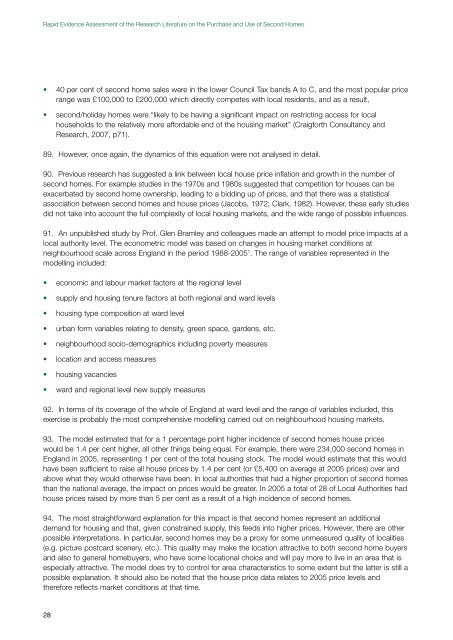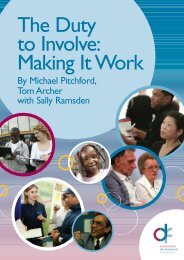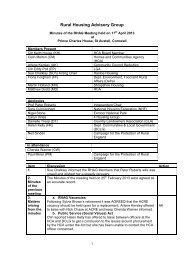Rapid Evidence Assessment of the Research ... - Rural Housing
Rapid Evidence Assessment of the Research ... - Rural Housing
Rapid Evidence Assessment of the Research ... - Rural Housing
Create successful ePaper yourself
Turn your PDF publications into a flip-book with our unique Google optimized e-Paper software.
<strong>Rapid</strong> <strong>Evidence</strong> <strong>Assessment</strong> <strong>of</strong> <strong>the</strong> <strong>Research</strong> Literature on <strong>the</strong> Purchase and Use <strong>of</strong> Second Homes<br />
• 40 per cent <strong>of</strong> second home sales were in <strong>the</strong> lower Council Tax bands A to C, and <strong>the</strong> most popular price<br />
range was £100,000 to £200,000 which directly competes with local residents, and as a result,<br />
• second/holiday homes were “likely to be having a significant impact on restricting access for local<br />
households to <strong>the</strong> relatively more affordable end <strong>of</strong> <strong>the</strong> housing market” (Craigforth Consultancy and<br />
<strong>Research</strong>, 2007, p71).<br />
89.<br />
28<br />
However, once again, <strong>the</strong> dynamics <strong>of</strong> this equation were not analysed in detail.<br />
90. Previous research has suggested a link between local house price inflation and growth in <strong>the</strong> number <strong>of</strong><br />
second homes. For example studies in <strong>the</strong> 1970s and 1980s suggested that competition for houses can be<br />
exacerbated by second home ownership, leading to a bidding up <strong>of</strong> prices, and that <strong>the</strong>re was a statistical<br />
association between second homes and house prices (Jacobs, 1972; Clark, 1982). However, <strong>the</strong>se early studies<br />
did not take into account <strong>the</strong> full complexity <strong>of</strong> local housing markets, and <strong>the</strong> wide range <strong>of</strong> possible influences.<br />
91. An unpublished study by Pr<strong>of</strong>. Glen Bramley and colleagues made an attempt to model price impacts at a<br />
local authority level. The econometric model was based on changes in housing market conditions at<br />
neighbourhood scale across England in <strong>the</strong> period 1988-20051 . The range <strong>of</strong> variables represented in <strong>the</strong><br />
modelling included:<br />
• economic and labour market factors at <strong>the</strong> regional level<br />
• supply and housing tenure factors at both regional and ward levels<br />
• housing type composition at ward level<br />
• urban form variables relating to density, green space, gardens, etc.<br />
• neighbourhood socio-demographics including poverty measures<br />
• location and access measures<br />
• housing vacancies<br />
• ward and regional level new supply measures<br />
92. In terms <strong>of</strong> its coverage <strong>of</strong> <strong>the</strong> whole <strong>of</strong> England at ward level and <strong>the</strong> range <strong>of</strong> variables included, this<br />
exercise is probably <strong>the</strong> most comprehensive modelling carried out on neighbourhood housing markets.<br />
93. The model estimated that for a 1 percentage point higher incidence <strong>of</strong> second homes house prices<br />
would be 1.4 per cent higher, all o<strong>the</strong>r things being equal. For example, <strong>the</strong>re were 234,000 second homes in<br />
England in 2005, representing 1 per cent <strong>of</strong> <strong>the</strong> total housing stock. The model would estimate that this would<br />
have been sufficient to raise all house prices by 1.4 per cent (or £5,400 on average at 2005 prices) over and<br />
above what <strong>the</strong>y would o<strong>the</strong>rwise have been. In local authorities that had a higher proportion <strong>of</strong> second homes<br />
than <strong>the</strong> national average, <strong>the</strong> impact on prices would be greater. In 2005 a total <strong>of</strong> 28 <strong>of</strong> Local Authorities had<br />
house prices raised by more than 5 per cent as a result <strong>of</strong> a high incidence <strong>of</strong> second homes.<br />
94. The most straightforward explanation for this impact is that second homes represent an additional<br />
demand for housing and that, given constrained supply, this feeds into higher prices. However, <strong>the</strong>re are o<strong>the</strong>r<br />
possible interpretations. In particular, second homes may be a proxy for some unmeasured quality <strong>of</strong> localities<br />
(e.g. picture postcard scenery, etc.). This quality may make <strong>the</strong> location attractive to both second home buyers<br />
and also to general homebuyers, who have some locational choice and will pay more to live in an area that is<br />
especially attractive. The model does try to control for area characteristics to some extent but <strong>the</strong> latter is still a<br />
possible explanation. It should also be noted that <strong>the</strong> house price data relates to 2005 price levels and<br />
<strong>the</strong>refore reflects market conditions at that time.






